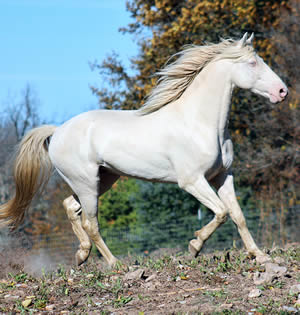History
The Missouri Fox Trotter was developed in the rugged Ozark Mountains during the nineteenth century by setters who needed smooth-riding, durable mounts that could travel at a comfortable, surefooted gait for long distances.
Missouri achieved statehood in 1821 and the pioneers who streamed across the Mississippi River to settle in the Ozarks came mostly from the hills and plantations of Kentucky, Tennessee and Virginia.
They brought with them their finest possessions, including their best saddle stock. The breeding of this stock was largely Arabian, Morgan and plantation horses from the deep south. Later more American Saddlebred, Tennessee Walking and Standardbred breeding was added. It soon became apparent that horses able to perform the easy, broken gait called the "fox trot" were the most useful in the rocky, forest-covered hills of the Ozarks, and selective breeding of the fox trot gait began.
Easy-gaited stock imported to America's shores during the colonial era left its genetic imprint on the fox-trotting horse in the Ozarks, the American Saddle Horses of Kentucky and the walking horses of Tennessee. Some nineteenth century greats, such as the Canadian stallion, Tom Hal, made sizeable contributions to the easy-gaited horses of all three regions.
The distinguishing characteristic of the Missouri Fox Trotter is the fox trot gait. The Fox Trot is basically a diagonal gait like the trot, but the horse appears to walk with its front legs and trot with his hind legs. Because of the back feet's sliding action, rather than the hard step of other breeds, the rider experiences little jarring action and is quite comfotable to sit for long periods of time without posting or "standing" in the saddle.
The ability to travel long distances at a comfortable speed of five to eight miles an hour made the Fox Trotting Horse a favorite of the country doctor, sheriff, assessor and stock raisor. Today the breed is in demand as a pleasure horse, show horse and for cross-country trail riding. It is often described as the common man's pleasure horse because of its gentle disposition.
Missouri ranks number two in the nation in cow-calf operations and Missouri Fox Trotting Horses are historically tied to the grazing cattle industry of the Ozarks. When automobiles made horses almost obsolete in the everyday lives of most Ozarkians, Missouri Fox Trotting Horses survived largely because the cattlemen of the region continued to use and breed them. Old Fox, one of the breed's most influential sires, was a chestnut stallion that spent his adult life trailing cattle in southern Missouri and northern Arkansas early in this century.
Many famous families of the Fox Trotting Horse have been known throughout the Ozarks and even to this day, the names of Copper Bottoms, Diamonds, Brimmers, Red Bucks, Chiefs, Steel Dusts, Cold Decks and many others are recognized by horse breeders everywhere.
Because of their stamina and smooth ground-covering gaits, the Missouri Fox Trotter has become very popular with field trail competitors and those involved in the sport of long distance trail riding. Today there are approximately 52,000 registered throughout the United States, Canada, Austria and Germany.
Behavior
The Missouri Fox Trotting Horse is known best for the comfort if affords its rider. Loved as a trail horse, 90 percent of registered Missouri Fox Trotters are owned by people who use them for trail riding, competition and endurance riding, and pleasure riding. Acclaimed as a show horse the Missouri Fox Trotting horse is also recognized for its beauty and style in the show ring.
Used by hunters and forest rangers for it's endurance and surefootedness in rugged terrain, by ranchers for it's versatility and intelligence, and on Hollywood movie sets for its gentle nature the breed has quickly earned its reputation as a horse for all situations.
Function
Missouri Fox Trotters are used extensively by trail riders, who appreciate their gaits, stamina and weight-carrying abilities. They are also used in handicapped riding programs, and their smooth gait has proven useful for riders with minor physical disabilities. Crosses between Fox Trotter mares and donkey jacks are often made, creating mules with the fox trot gait that are used to carry hunters and trail riders, especially in the western United States.






